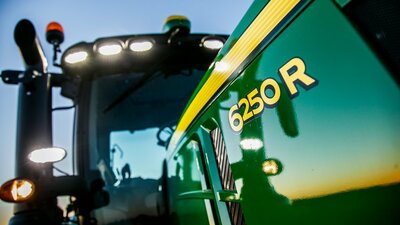
Officially revealed last December, John Deere's 6250Rs are now starting to make their way to the UK.
Richard Bradley put the new machine to work.
Aiming to offer a high power to weight ratio, John Deere hopes its 6250R will bridge the gap between its smaller Mannheim-manufactured 6R Series and the brutish American-built 7R tractors.
Despite the bulk of its sales taken up by 6150R and newer generation 6155R, John Deere saw a demand for a more powerful version of its equally popular 6215R, but without the burdening weight or bulk of the larger 7R.
Intro 2
To find out what its targeted users were looking for, John Deere consulted a group of 10 major contractors from around Europe, to try and create a tractor which has plenty of grunt to run power hungry machines such as butterfly mowers, remain nimble enough for transport duties, yet can also be weighted up for heavy draft applications.
The outcome was a two-model extension to the 6R range; the 6230R and 6250R. Deere claims the 6250R has a power to weight ratio of 31kg/hp when boosted up to maximum 300hp, compared to about 35kg/hp for both the 6155R and 6215R when they are at their maximum.
Aside from its hike in power, the manufacturer's dealing with the contractor group also revealed they were looking for more advanced controls, so the firm set about a multifunction joystick to add to its tried and tested CommandArm console.
To see if the new tractor is up to size, and to get a better understanding of the controls, we were able to follow the firm's new 700 Series combine, equipped with a 6250R and a high density L1534 large square baler.
John Deere 6250R Specifications
- Engine: 6.8-litre JD PowerTech PSS
- Rated power: 250hp
- Maximum power: 300hp
- Maximum torque: 1,167Nm @1,600rpm
- Transmission: ZF AutoPowr CVT, 40kph or 50kph option
- Hydraulics: 160 litres per min @1,500rpm
- Rear linkage lift capacity: 10,400kg
- Front linkage lift capacity: 5,000kg
- Turning circle: 12.64m
- Unladen weight: 9,300kg
- Maximum permissible weight: 15,000kg
- Wheelbase: 2.9m
- Retail price: £216,686 (by comparison, 6215R is £194,599 and the 7250R is £210,800)
Competition

The class in which the 6250R sits can be easily debated; does it have the edge in the lightweight category, or will be trying to nip at the heels of similar weighted machines, albeit with lower rated power figures.
Powertrain and running gear
With strong blood lines dating back 25 years to Deere's first 6000 Series tractors, the 6250R uses the same engine block and full-frame chassis design concept as those early six-potter machines. Also used in the 6215R, the 6.8-litre engine in the 6250R features reinforced crankshaft, pistons and cylinder head to cope with the extra grunt.
To prevent simply snapping the tractor in half by unleashing the maximum 300 gee-gees at once, the 6250R features a power boost function called Intelligent Power Management. During transport duties, when below 13kph (8mph) only 250hp is available, at which point the extra 50hp gradually kicks in to provide full power at 15kph (9mph). For pto work, the same applies from forward speeds of 1kph (0.6mph).
Powertrain body 2
When pushing on in some bulky straw swaths, the 6250R's full power managed the baler with ease, and did not stutter even when the baler decided it had bitten off more than it could chew, and tripped out the cam-clutch. For heavy draft applications, however, you will only realistically be gifted with 250hp, potentially knocking the Deere down against its seemingly unboosted competition.
To keep the engine running cool larger cooling packs have been fitted, along with a viscous fan, which according to John Deere, only runs when required so should reduce power and inevitably fuel consumption.
Due to its size increase, the cooling pack requires a slightly larger bonnet, and has forced the air intake from under the bonnet to alongside the cab pillar. Moving the filter should be welcome to drivers, as accessing the filter previously required climbing into the engine bay itself. To make daily checks easier, a small hatch has been fitted to the bonnet, which hides engine oil dipstick and filler.
Engine pic
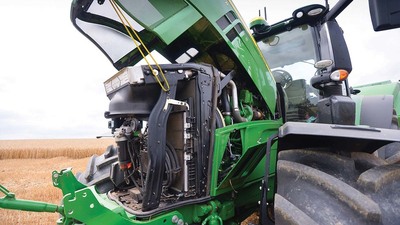
6.8-litre JD PowerTech engine is also used in some smaller 7R Series tractors.
Powertrain body 3
Following on with the reinforced theme, a beefed up version of ZF's AutoPowr continuously variable transmission (CVT) was required for the 6250R, which adds about 100mm in length to the tractor's wheelbase, compared to the 6215R. Responses to transmission inputs at working speeds are positive, with full throttle acceleration once all 300hp is unleashed being particularly brisk.
To maintain forward views over the slightly longer and taller bonnet, cab height has been raised slightly over the 6215R. While only marginal, it does make the climb into cab a little more difficult.
Other areas worth noting is the newly designed front axle, which allows increased lift capacity of five tonnes through the standard front linkage, and also allows taller 600/70 R30 front tyres to be fitted to increase ground contact. While taking design cues from its larger 7R series with double-acting outboard cylinders, the new Dana-supplied unit operates similarly to existing 6R suspension, and has allowed maximum permissible weight to be upped to 15tonnes.
Toolbox pic
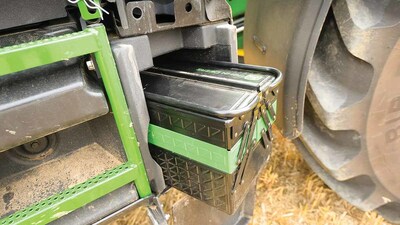
One requirement from the contractor group was storage for a proper toolbox. To make life easier, production models will get a pull-out drawer for the box.
Controls
A major talking point in the 6250R is Deere's new CommandPro controller, which is set to complement the logical CommandArm console.
Now, it takes no genius to see that JD has spent time evaluating controls offered by other manufacturers, selecting only the best bits and incorporating them into its controller. The result is a very good effort. The lever itself falls easily to hand like a pistol grip, with a number of clearly identifiable buttons underneath your thumb and index finger.
Controls body 2
Getting the tractor rolling can be done in a number of ways, as can taking up speed, setting the speed and reaching maximum speed (see joystick graphic).
First off, the tractor can be used in pedal mode; knock the new return-to-centre shuttle lever forward and give it some throttle. Alternatively, all movements can be set off from the joystick, via the use of a consent button. Once rolling, if you hold the consent button and knock the joystick left this shuttles between forward and reverse.
Ideal for transport duties, the forward and backward movement of the joystick to control increase/decrease speed also features a detent, which with one click can take the tractor to maximum speed, or to a standstill. While movement of the joystick is not proportional to adjustment in speed increase, speed uptake is determined by how long the joystick is held forward. Two adjustable transmission cruise speeds are featured, engaged by knocking the joystick to the right, and switched by a rocker on the joystick. A thumb scroll wheel is also featured to adjust these.
One area which can stump some CVT drivers is when trying to inch up to an implement or trailer. Thankfully, when held to the left, moving the CommandPro joystick forward and back engages an inching system which allows the tractor to move at precise speeds up to 2kph.
Joystick graphic
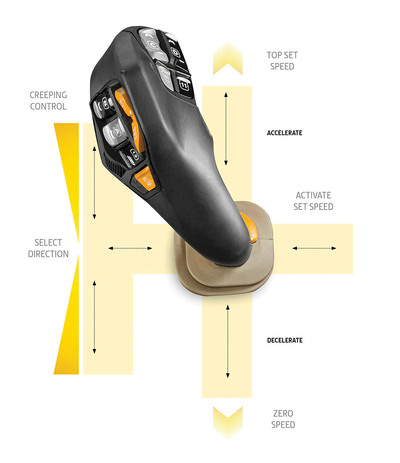
Controls body 3
To ensure the tractor is simple to jump on and drive, simply using the stick or pedal will select that drive mode, and the using the brake or clutch will disengage stick mode. If the foot pedal is used when travelling at a set speed, it will allow forward speed to be increased without altering engine revs, ideal when going into a light patch when mowing, for instance.
John Deere says most tractor functions can be controlled without taking your hand away from the joystick, thanks to a number of programmable buttons and rocker switches. Three buttons can be programmed to engage auto steer, headland management functions, ptos and engine speed memories, and three rocker switches can look after spools or front and rear linkages. IsoBus functions can also be set through any of the joystick buttons.
As well as this, traditional switches for spools, rear linkage and pto are still featured on the CommandArm armrest, along with the current joystick, which as before can be programmed to suit the driver. Setting up the tractor from scratch is relatively simple through the large 4600 CommandCentre's configuration screen. While only a slight niggle, rocker switches on the joystick are not proportional.
John Deere says it has tried to keep the console as customisable as possible, to allow varied setups according to implements, conditions and users. To make sure you do not spend all day changing settings for each task, a vast amount of profiles can be stored for different implements and users. These are recalled when first turning the key, or can be changed at any time.
CommandArm pic
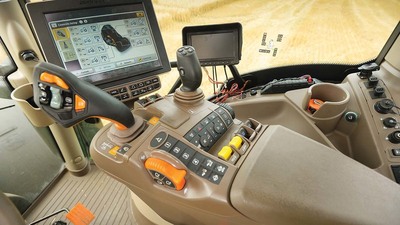
Control via the well laid out CommandArm and CommandCentre touch screen is straightforward, and becoming fairly common across most Deere machines.
FG Verdict
While the whole control concept of the 6250R may sound a little complicated, the uncluttered screen and a few simple diagrams make the new CommandPro extremely simple to setup and use. Without comparing side-by-side with other brands, we believe this could be one of the best control systems currently on the market. And, inevitably this will be filtering down to become an option on the remaining 6R range.
As for the tractor itself, the arrival of the 6250R has been long awaited to get JD into the lightweight, high horsepower tractor sector. There is no doubt with its boost engaged, the 6250R should tick most boxes with plenty of power and a decent maximum permissible weight, while remaining nimble and lightweight when required.
Naturally, contractors will progress up the power ladder to the 6250R, however, the question has to be asked will this be seen as a plucky David in the 300hp sector, or a lumbering Goliath competing with 250hp machines.
Verdict pic
